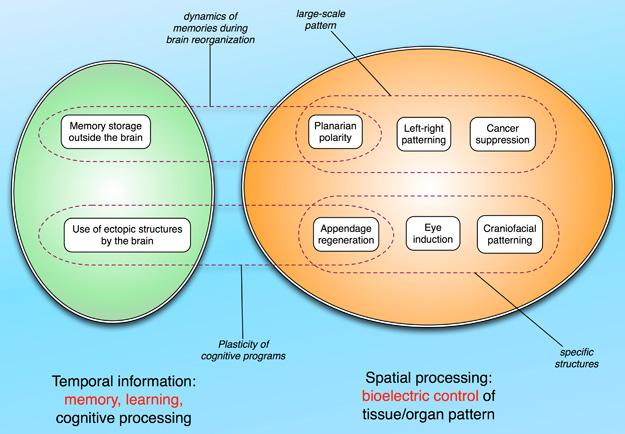Research on the Dynamics of Information Processing in Biological Structures
Biological information comes in (at least) 2 flavors: spatial information (3-dimensional structure or topology of tissues, organs, and whole organisms), and temporal information (perceived patterns within environmental stimuli that occur in time). Both of these kinds of information need to be detected, remembered, and processed by cells and tissues to guide their function. Our lab uses a convergence of molecular biophysics and computational modeling to understand how this occurs at multiple levels of organization. The results of this effort will not only shed light on the fundamental nature of real living creatures but also will provide important clues to the capabilities of "life-as-it-could-be" in synthetic biology or hybrid cybernetic systems. The former ties our work to the biomedicine of birth defects, traumatic injury, and cancer. The latter has implications for the design of artificial life and the engineering of robust, adaptive devices and novel computational media. Altogether, we view this as a branch of information or computer science as much as it is biology.
Our lab current mind-map can be schematized this way:
Temporal Information
Biological structures have remarkable abilities to perceive patterns in the signals which impinge upon them, which manifest as learning, plasticity, and adaptive behavior. Although traditionally this is studied by neurobiology and behavior science, it is not exclusively a property of neural networks. We are interested in signal processing and pattern inference by somatic tissues that detect and organize information during pattern formation and homeostatic physiology. This includes questions of memory storage outside the CNS, adaptive plasticity in the brain, neural control of growth and form, and the mapping of cognitive programs on radically altered body structures.
Learn more about temporal information
Spatial Information
Most of the interesting questions in biology boil down to the control of shape. We all start life as a single cell – the egg, which somehow self-assembles into an incredibly complex organism (whether it be an oak tree, rabbit, or snail). The question of how it is able to achieve its intended pattern (or "morphology") is the main issue of developmental biology. However, this problem is relevant throughout the life-span: as the body's cells age and die, they are replaced so that the organism remains intact. Moreover, some organisms are good at repairing damage – salamanders re-grow limbs, hearts, eyes, and jaws if they are amputated. Thus, the body has to know when it is damaged, and decide precisely which growth programs to activate to get back to the original shape (and know when to stop growing). Even cancer is part of this puzzle, because tumors are, in an important sense, a disease of geometry – cancer results when cells stop attending to the normally tight patterning controls of the organism, and can sometimes be tamed by the strong patterning influence of regenerative or developmental processes. Thus, developmental, regeneration, and cancer biology all share a fundamental set of questions: how do cellular systems know what shape to build, and through what molecular mechanisms do they build that shape? We are interested in the information processing, communication, and computations that go on as cell groups perceive current patterning states of the host and change their behavior towards specific morphogenetic goals.
